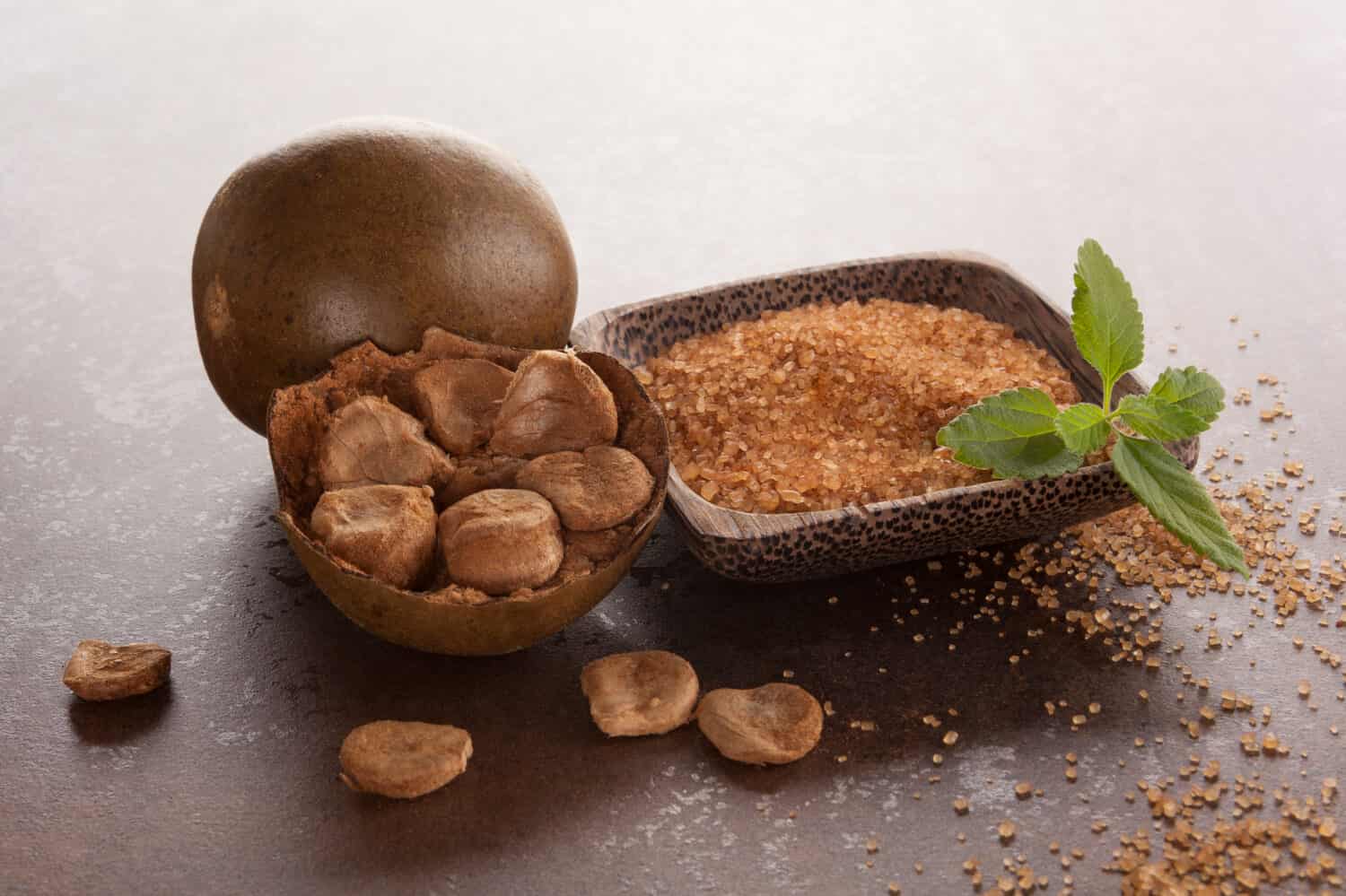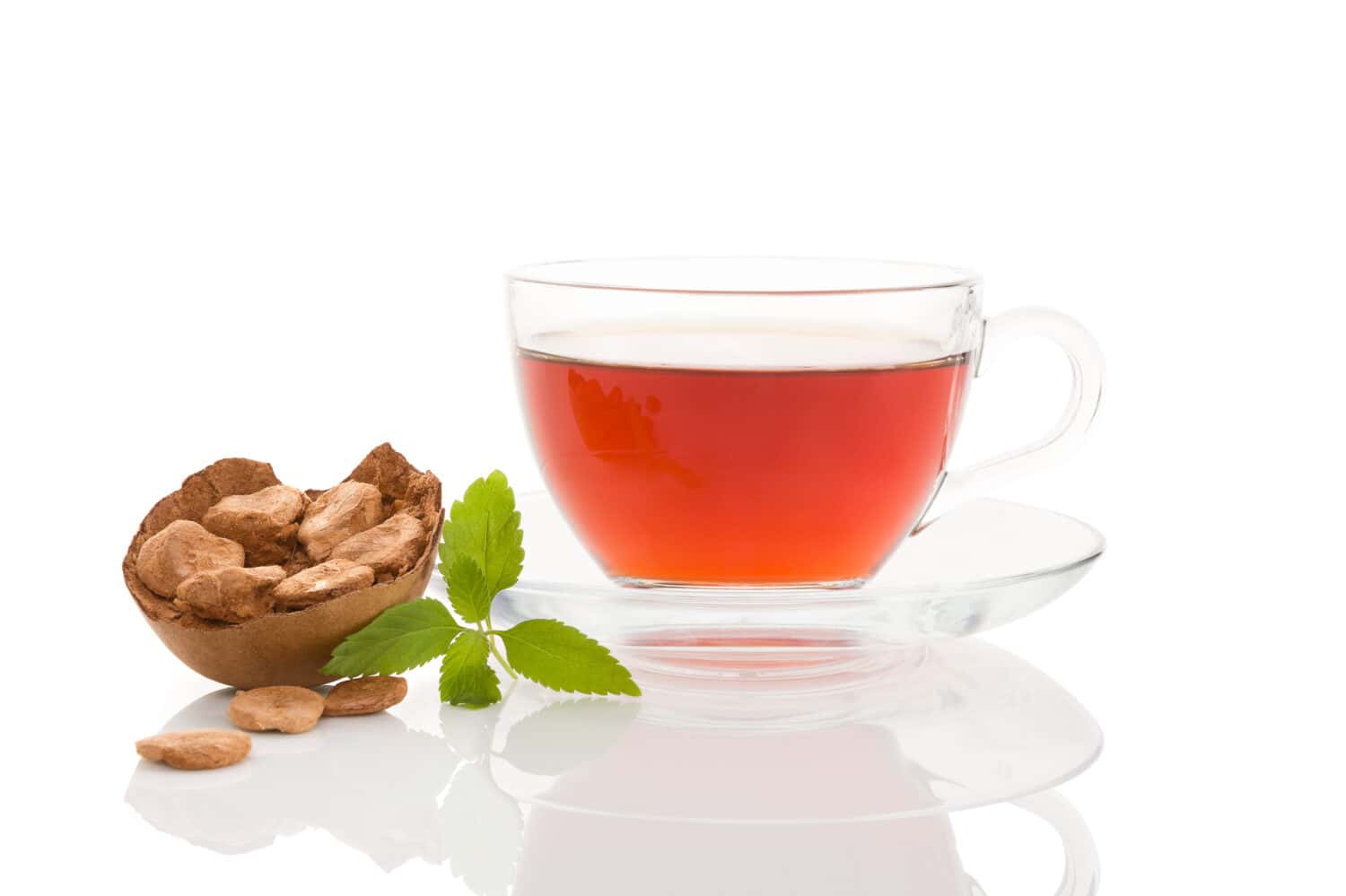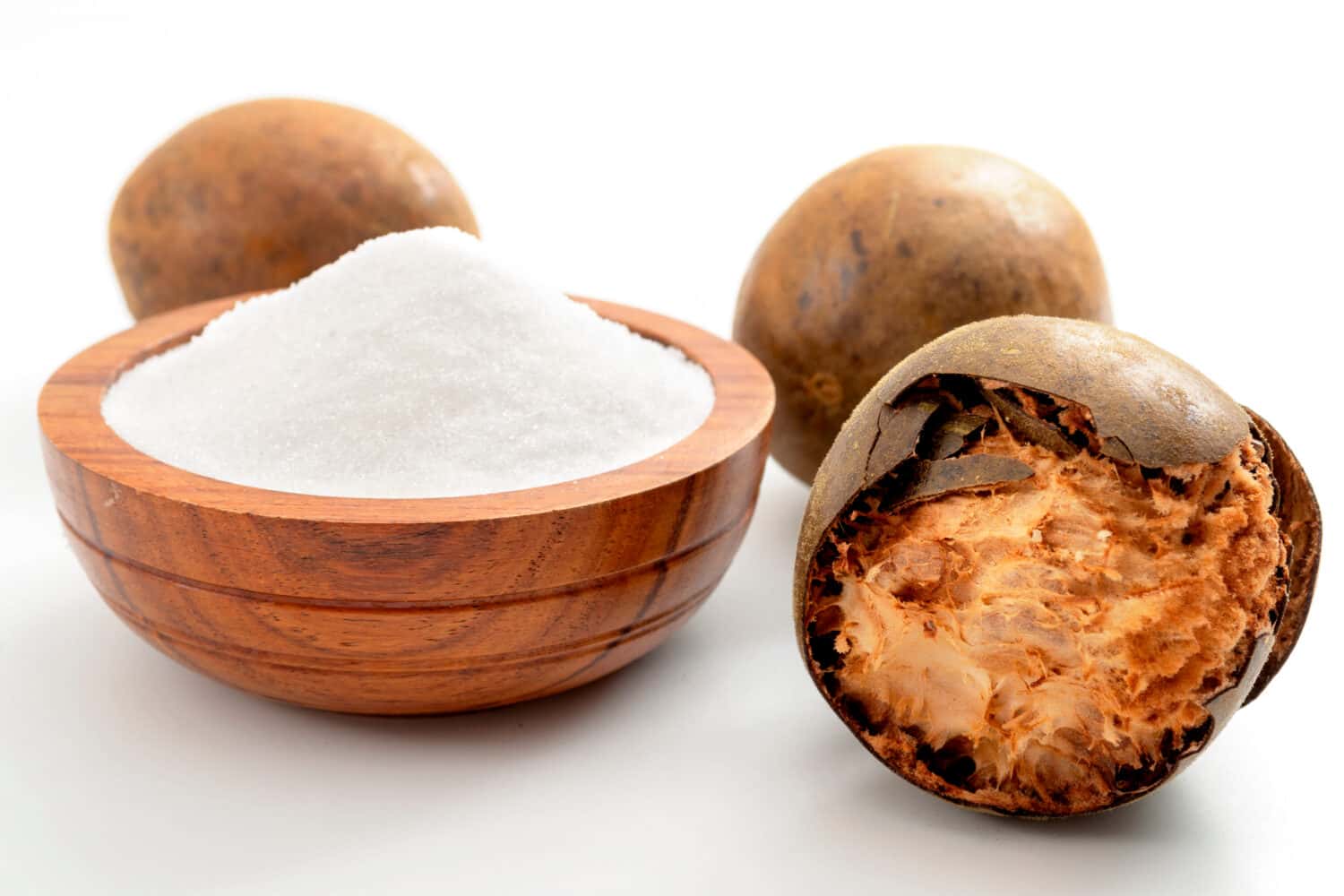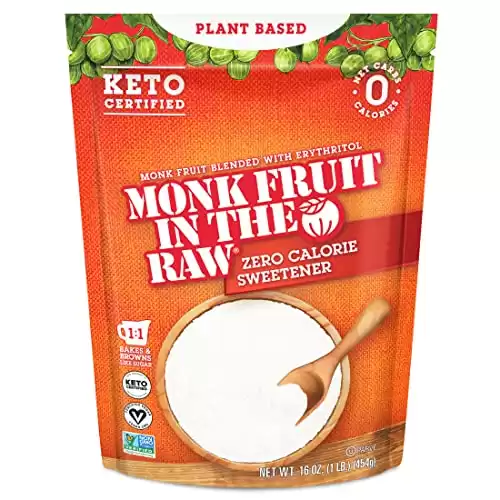Monk fruit has a rich cultural history, originating in Southern Asia, and is still almost exclusively grown, cultivated, and exported from Thailand and China. This small round melon fruit is a member of the gourd family and is also known as “Buddha Fruit” or swinglefruit (Siraitia grosvenorii). However, natively, it is referred to as Luo Han Guo.
According to Eastern legends, monk fruit was first discovered by Buddhist monks in the Guangxi Province of China, specifically in the misty mountain forests of Guilin. In this article, we will explore what science says about monk fruit and whether it is a healthy alternative to commonly used sugars.

©Eskymaks/Shutterstock.com
Is Monk Fruit Healthy?
In our modern world, we have realized that calorie intake and blood sugar levels greatly affect our daily and long-term health. Thus, other sweet alternatives are now often incorporated into our diet to add flavor without the usual unhealthy drawbacks of sugarcane-based sugars. Monk fruit is now also accepted and utilized as an all-natural sweetener. It is between 150 and 200 times sweeter than typical Western sugar. Monk fruit is proven to be a zero-calorie sweetener. It is more effective than its usual counterparts and requires much lower quantities to achieve the same, much-loved, palatable flavor.
What Is Monk Fruit Used For?
Originally, monk fruit was used as a traditional Chinese medicine and is still used to treat the common cold and intestinal issues. Recently, monk fruit has been recognized as a genuine sugar alternative, and unlike some other sweeteners, it is noted to have almost no aftertaste.
Shockingly enough, a study shows that on average, American citizens add up to 57 pounds of refined sugar to their diet, excluding the existing sugar content already present in their meals, per year. This can cause many health issues and decrease life expectancy.
Alternatively, monk fruit sugar has many proven health benefits, serving as a wonderful substitute for the health-conscious and for those who need to control their blood sugar balance or weight.
Compared to regular white or brown sugar, monk fruit offers that sweet flavor without calories and added carbohydrates, so it does not affect blood sugar levels. This makes it a much healthier alternative.

©Eskymaks/Shutterstock.com
Is Monk Fruit Sugar Safe?
In a word, yes. Monk fruit sugar has been approved as safe for consumption in over sixty countries worldwide. In America, it has been approved by the U.S. Food and Drug Administration (FDA) and is registered as Generally Recognized As Safe (GRAS) in America. It is often combined with erythritol, giving it a more conventional sugar texture, which is also FDA-approved.
Uses for Monk Fruit Sugar
There are a variety of ways to incorporate monk fruit sugar into your diet, and as it is much sweeter than other typical sugars, a smaller amount is required.
Monk fruit sugar can be used wherever sweetness is required; you can add it to your daily cup of coffee or favorite hot beverage without the added carbohydrates and calories. Furthermore, it can be added to cereals and smoothies, sprinkled on fruit, or even used when baking.
When used in baking, it is a great substitute, as it is stable at high temperatures. Just remember, it is much sweeter than regular sugar, so a quarter of what the recipe asks for is the usual conversion ratio.
How Is Monk Fruit Sugar Made?
Monk fruit sugar is composed of mogrosides, as opposed to sucrose-based sugar, which is refined from sugar cane, the most commonly accepted table or baking sugar. There are three main steps to refine monk fruit sugar from the actual fruit.
Firstly, the skin is peeled off, and the seeds are then removed. Next, the remaining fruit pulp is processed by adding hot water and then crushing and filtering it to separate the liquid from the solid content. Lastly, the liquid extraction is dehydrated to form a dry powder. This powder can then either be used raw or combined with erythritol, as previously mentioned, for a more recognized texture.
How Much Monk Fruit Sugar Should One Consume Daily?
Monk fruit is an incredibly concentrated sweetener, so smaller quantities are typically needed, though studies have shown no adverse effects even when consumed in high quantities. It is advised to use all sweeteners in moderation, and monk fruit sugar is no exception.
Nutritional Value of Monk Fruit Sugar Compared to Sucrose Sugar.
In comparison to normal table or baking sugar, which contains around four calories per gram, monk fruit sugar is metabolized differently and has a slight, basically zero, calorie content.
This makes it excellent for those wanting to cut calories, and it also has no noticeable effect on blood glucose levels, making it excellent for those needing to manage their blood sugar levels.
The Health Benefits of Monk Fruit Sugar
There are a multitude of health benefits, especially in contrast to sucrose sugar; some of these are:
- It assists in glycemic control as it does not affect blood sugar levels.
- Mongrosides, the actual sweetener in monk fruit sugar, have anti-inflammatory properties.
- Mongrosides have antioxidant properties, which are proven to assist the body in preventing and fighting cancer.
- Monk fruit sugar helps in calorie intake reduction, as it is metabolized differently. This assists in helping you control your body weight.
- Lower quantities are needed as it is much sweeter than normal sugar; a pinch is usually enough to replace a teaspoon, meaning it goes further.
- There is no real sugar in monk fruit sugar, it does not cause cavities or tooth decay, a notable and wonderful benefit for children and adults.
Baking With Monk Fruit Sugar
As previously mentioned, monk fruit sugar provides up to 200 times the craved sweet flavor of table sugar. As a result of its incredible sweetness, only around a quarter volume is needed when baking compared to usual sugar quantities. Some experimentation may be required if the texture is not completely identical.
Print
Monk Fruit Sugar Cookies
- Total Time: 20 minutes
- Yield: 1 dozen 1x
Description
Below is a wonderful recipe for monk fruit sugar cookies that you can try this weekend.
Ingredients
- 1/2 teaspoon baking powder
- 10 tablespoons of softened, unsalted butter
- 2/3 cup of sugar
- 1 large egg, plus 1 extra egg yolk, at room temperature
- 1 teaspoon vanilla extract
- 2/3 of a cup of “Monk Fruit in The Raw Bakers Bag”
- 2 cups unbleached all-purpose flour
- 1/4 teaspoon of salt
Instructions
- Preheat the oven to 350 degrees Fahrenheit.
- Combine the baking powder, flour, and salt in a bowl. Then set it aside.
- Beat the butter in an electric mixer on medium-high until it’s fluffy, usually two minutes. Add the sugar and mix further until the mixture is thoroughly blended, about three minutes.
- Next, add the vanilla essence, egg, and extra yolk, beating until completely mixed. Then add the “Monk Fruit in the Raw Bakers Bag” and mix lightly. Set the mixer to low speed, incrementally add the remaining dry ingredient, and blend until the mixture is still lumpy but not completely smooth. Continue to scrape the mixture off the sides using a flexible spatula.
- Separate the dough in half and place it on the counter in plastic wrap. The mixture should be soft and sticky.
- Then shape it into rectangular rounds approximately five inches wide and six inches long, and place them in the fridge to chill for 3 hours.
- Next, roll out each section on a floured counter until it is a quarter inch thick; remember to dust the top with flour as well to prevent sticking. Use a cookie cutter to shape the cookies into your desired shape.
- Line them out on a baking tray, leaving a two-inch gap between each one to allow it to rise.
- Bake for 10–12 minutes, or until golden brown; allow to rest for 5 minutes before removing from the tray and decorating.
- Prep Time: 8 minutes
- Cook Time: 12 minutes
- Made from nature's finest monk fruit, also known as Luo Han Guo, native to Asia
- Keto Certified, Non-GMO Project Verified, Vegan and Kosher
- Zero-calorie, zero-net-carbohydrate plant-based sweetness
- It measures 1:1, just like sugar
Final Thoughts
As discussed above, though monk fruit sugar may seem more expensive than refined sugar, the quantities required are approximately a quarter. This makes it financially viable as well as a healthier alternative when compared to processed sugar. It is also suitable for those who exploit a keto diet. To add, there is no added artificial sucrose to monk fruit sugar making it ideal for people who have type 1 and type 2 diabetes.
Furthermore, regular sugar affects your calorie intake and can cause tooth decay and cavities. On the other hand, monk fruit sugar has neither of these drawbacks, making it a more wholesome ingredient to incorporate into your daily diet and a perfect sugar alternative to incorporate into your children's diet.
Monk fruit has been recognized in Eastern culture for over eight decades, it has become more popular in other countries due to its amazing benefits. Nevertheless, substituting normal sugar for monks’ fruit sugar can improve your sugar levels and help you to maintain a balanced diet.
The image featured at the top of this post is ©Victor Moussa/Shutterstock.com.


